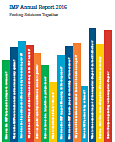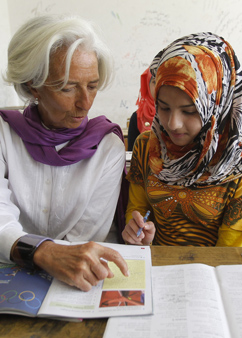IMF Policy Challenges and Priorities
The Managing Director’s Global Policy Agenda (GPA) is presented twice a year to the International Monetary and Financial Committee (IMFC), which is the IMF’s policy guiding body. The GPA identifies the policy challenges faced by the IMF membership, assesses progress since the previous GPA, outlines the policy responses needed at the global and country levels, and lays out how the IMF can support those policy responses.
The April 2016 GPA focused on policies to put the global economy back on a stronger and safer track. It said countries should boost their commitment to growth and employ a three-pronged approach of mutually reinforcing policy levers, bolstered by a well-functioning financial sector and global cooperation.
Monetary Policy
In advanced economies, monetary policy should remain accommodative where output gaps are negative and inflation is too low. But monetary policy needs to be accompanied by other policies in providing the necessary demand support and cannot address structural bottlenecks to growth. Unconventional monetary policies are helping to support demand, although very low—and in some cases negative—interest rates may also have direct effects on bank profitability. In emerging economies, monetary policy must grapple with the impact of weaker currencies on inflation and private sector balance sheets.
Fiscal Policy
There is a strong case for domestic coordination across policies. While some countries continue to suffer from high debt, elevated sovereign spreads, and low public sector savings, and need to implement their fiscal consolidation plans, those with fiscal space should commit to ease fiscal policy further. For a number of creditor countries, this would also help facilitate global rebalancing. All countries can also contribute by aiming for a more growth-friendly composition of revenue and expenditure, particularly increased spending in infrastructure in some countries.
Structural Reforms
The need for structural reforms to improve productivity and potential output is widely recognized. Many commitments have been made—including in the context of the G20—but delivery must be pulled forward. Countries with fiscal space should take advantage of synergies between demand support policies and structural reforms. Structural reforms with built-in fiscal stimulus can have positive near-term effects. Given the diversity of the structures of economies, individual structural reform priorities should be sequenced and reflect differences in stages of economic development and strength of institutions. In commodity exporters and low-income developing countries, policies to promote economic diversification and structural transformation are essential.
Financial Sector Action
Solutions are also needed to prevent de-risking from unduly impeding access to financial services, including correspondent bank relationships. Countries should take further steps to speed up the repair of private sector balance sheets, avoiding a protracted deleveraging process that weakens the credit channel of monetary policy and raises uncertainty. It is essential that the European Union’s Banking Union be completed by putting the last pillar—a common deposit guarantee scheme—in place, together with efforts to reduce risks in banking systems. Further progress is needed in consistently implementing and completing the global regulatory reform process, including policies to transform the shadow banking sector into a stable source of market-based finance.
Global Cooperation
Each country should commit to a set of policy actions that contributes to a global package of reforms to lift both national and global growth. A three-pronged approach, taken in concert by the membership, can mutually reinforce economic activity and reduce stability risks. Global cooperation is also needed. Examples include enhancing mechanisms for adjustment and liquidity provision, shoring up global trade, tackling corruption, and furthering the regulatory reform agenda.












